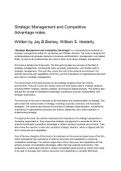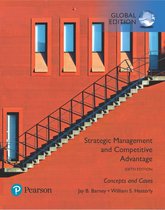Resumen
Strategic Management and Competitive Advantage: Summary
- Institución
- Universitat De Valencia (UV)
This summary consists in a quick recopilation of all the key information that is written by Jay B Barney, and William S. Hesterly in the book "Strategic Management and Competitive Advantage notes" in which the autors make some economics analysis, in order to help undergraduate and graduate students...
[Mostrar más]




